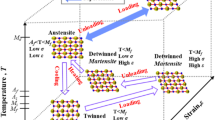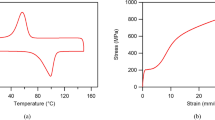Abstract
In the present work, simple tensile test of shape memory alloys (SMAs) is studied by considering stress concentration caused by the grippers. In order to simulate SMA behaviors, finite element method is employed to obtain prestress distribution along the specimen due to fastening the grippers prior to the application of tension. Then, Brinson’s 1-D constitutive model is used to study transformations during the tensile loading–unloading. It is found that the prestress leads to a non-uniform distribution of uniaxial stress as well as martensite volume fraction throughout a wire. Therefore, the so-called dog-bone geometry is suggested and optimum dimensions are proposed to obtain a uniform tensile stress distribution when testing an SMA specimen. This way, a nearly simultaneous transformation can be achieved along the whole specimen. The optimum dimensions are shown to be different from those reported by ASTM for tensile testing of SMAs. In fact, the optimum dimensions depend on material parameters of the test specimen.












Similar content being viewed by others
References
Auricchio F, Lubliner J (1997) A uniaxial model for shape-memory alloys. Int J Solids Struct 34:3601–3618
ASTM F2516–07 (2007) Standard test method for tension testing of nickel-titanium superelastic materials. ASTM International, West Conshohocken, PA, USA
Azadi B, Rajapakse RKND, Maijer DM (2006) One-dimensional thermomechanical model for dynamic pseudoelastic response of shape memory alloys. Smart Mater Struct 15:996–1008
Badnava H, Kadkhodaei M, Mashayekhi M (2014) A non-local implicit gradient-enhanced model for unstable behaviors of pseudoelastic shape memory alloys in tensile loading. Int J Solids Struct 51(23–24):4015–4025
Badnava H, Kadkhodaei M, Mashayekhi M (2015) Modeling of unstable behaviors of shape memory alloys during localization and propagation of phase transformation using a gradient-enhanced model. J Intell Mater Syst Struct 26(18):2531–2546
Brinson L (1993) One-dimensional constitutive behavior of shape memory alloys: thermomechanical derivation with non-constant material functions and redefined martensite internal variable. J Intell Mater Syst Struct 4:229–242
Chang B-C, Shaw J, Iadicola M (2006) Thermodynamics of shape memory alloy wire: modeling, experiments, and application. Contin Mech Thermodyn 18:83–118
Chung JH, Heo JS, Lee JJ (2007) Implementation strategy for the dual transformation region in the Brinson SMA constitutive model. Smart Mater Struct 16:N1
Churchill CB, Shaw JA, Iadicola MA (2009) Tips and tricks for characterizing shape memory alloy wire: part 3-localization and propagation phenomena. Exp Tech 33:70–78
Duval A, Haboussi M, Zineb TB (2010) Modeling of SMA superelastic behavior with nonlocal approach. Phys Procedia 10:33–38
Falk F (1980) Model free energy, mechanics, and thermodynamics of shape memory alloys. Acta Metall Mater 28:1773–1780
Frost M, Sedlák P, Sippola M, Šittner P (2010) Thermomechanical model for NiTi shape memory wires. Smart Mater Struct 19:353–368
Ghaemi F, Ebrahimi R, Hosseinifar R (2013) Optimization of die profile for cold forward extrusion using an improved slab method analysis. Iran J Sci Technol Trans Mech Eng 37:189
Iadicola MA, Shaw JA (2004) Rate and thermal sensitivities of unstable transformation behavior in a shape memory alloy. Int J Plast 20:577–605
Kamrani M (2012) Investigation on the effect of stress concentration on stress-strain response of SMA wires. M.Sc. Thesis, Isfahan University of Technology, Isfahan, Iran (in Persian)
Kamrani M, Kadkhodaei M (2013) An investigation into the simple tensile test of SMA wires considering stress concentration of grippers. J Mater Eng Perform 23:1114–1123
Kamrani M, Kadkhodaei M (2016) Investigation on local and global behaviors of pseudoelastic shape memory alloy wires in simple tensile test considering stress concentration of grippers. J Intell Mater Syst Struct 27(2):221–232
Liang C (1990) The constitutive modeling of shape memory alloys. Ph.D. Thesis, Virginia Tech
Müller I, Xu H (1991) On the pseudo-elastic hysteresis. Acta Metall Mater 39:263–271
Pahlevani Z, Ebrahimi R (2013) Optimization of specific die profiles in thin-walled tube extrusion. Iran J Sci Technol Trans Mech Eng 37:203
Rongqiao W, Chongdu C, Changboo K, Qiang P (2006) A proposed phenomenological model for shape memory alloys. Smart Mater Struct 15(2):393–400
Shariat BS, Liu Y, Rio G (2012) Thermomechanical modelling of microstructurally graded shape memory alloys. J Alloys Compd 541:407–414
Shariat BS, Liu Y, Rio G (2013a) Mathematical modelling of pseudoelastic behaviour of tapered NiTi bars. J Alloys Compd 577:S76–S82
Shariat BS, Liu Y, Rio G (2013b) Modelling and experimental investigation of geometrically graded NiTi shape memory alloys. Smart Mater Struct 22:25–30
Shaw JA (2000) Simulations of localized thermo-mechanical behavior in a NITI shape memory alloy. Int J Plast 16:541–562
Shaw JA (2002) A thermomechanical model for a 1-D shape memory alloy wire with propagating instabilities. Int J Solids Struct 39:1275–1305
Sun QP, He YJ (2008) A multiscale continuum model of the grain-size dependence of the stress hysteresis in shape memory alloy polycrystals. Int J Solids Struct 45:3868–3896
Tanaka K, Nagaki S (1982) A thermomechanical description of materials with internal variables in the process of phase transition. Ing Arch 51:287–299
Zare F, Kadkhodaei M, Salafian I (2015) Thermomechanical modeling of stress relaxation in shape memory alloy wires. J Mater Eng Perform 24(4):1763–1770
Author information
Authors and Affiliations
Corresponding author
Rights and permissions
About this article
Cite this article
Jamalimehr, A., Ravanbakhsh, H., Kadkhodaei, M. et al. Investigation of Dog-Bone Geometry for Simple Tensile Test of Pseudoelastic Shape Memory Alloys. Iran J Sci Technol Trans Mech Eng 40, 337–345 (2016). https://doi.org/10.1007/s40997-016-0037-1
Received:
Accepted:
Published:
Issue Date:
DOI: https://doi.org/10.1007/s40997-016-0037-1




